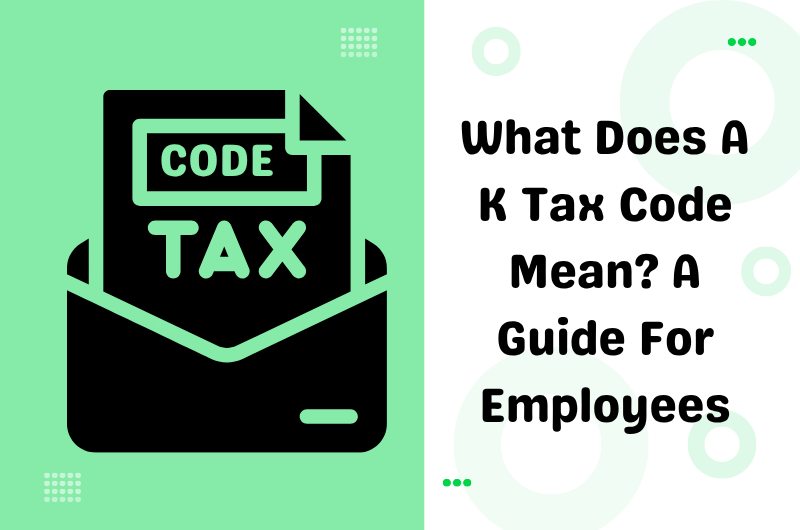What Does A K Tax Code Mean? A Guide For Employees
Indisputably, you will never want to go through the inconvenience of under- or overpaying your tax since this will be an additional hassle. This signifies how essential it is for you to understand that your tax code is vital to ensure you are paying the correct amount of Income Tax. You can usually find your tax code in the top right of your payslip on the same row as your name. Importantly, among the range of tax codes assigned by HMRC in the UK, there is one tax code that often raises questions: the “K” tax code. Thus, this blog aims at decoding what does a K tax code mean, including when it is assigned, its implications, and how it affects employees’ payslips.
What Does A K Tax Code Mean?
HMRC assigns a tax code to inform employers or pension providers about how much income tax should be deducted from an individual’s salary or pension. A tax code is an accurate way for employers to determine and calculate their employees’ tax liabilities. Primarily, most tax codes consist of numbers and letters, each with a specific meaning. However, not all tax codes are straightforward, and some can indicate that an employee has underpaid tax or receives taxable benefits from their employer, which are going unreported. That is where the K tax code comes in.
Principally, an employee will find a K tax code (also known as a negative tax code) on their payslip when they have taxable income that is not being taxed in another way and is greater than their tax-free Personal Allowance. A K tax code does not appear often; rather, according to HMRC guidelines,
“The letter K is used in an employee’s tax code when deductions due for company benefits, state pension or tax owed from previous years are greater than their Personal Allowance. Employers will multiply the number in their tax code by 10 to show how much should be added to their taxable income before deductions are calculated.” A basic example of when you may get a K tax code is if your employer has provided you with an expensive company car.
In brief, a K tax code essentially means the employee owes tax on benefits, state pensions, or underpaid tax from previous years. Moving on, unlike other tax codes that represent how much tax-free income you can earn, the K code works in reverse, i.e. it shows how much extra income should be added to your salary before tax is calculated. It is because HMRC considers your unpaid tax liabilities as additional income. Thus, these additional or untaxed incomes may push you into higher tax bands, increasing your tax bill.
As stated before, employees will need to multiply the number given in their tax code by 10 to figure out how much will be added to their taxable income before tax is calculated. For example, if you have received a K200 tax code, HMRC instructs your employer to add £2000 to your wages when calculating how much tax you should pay over the year. Consequently, an additional £2000 of taxable income will be added to your annual earnings, causing you to pay more tax than someone with a standard tax code of 1257L.
For greater clarity, let’s understand the K tax code with the help of the following example:
- Your previous tax code has been the standard 1257L. However, your employer has now given you a company car for which the benefit in kind is £20,000. Now, HMRC will deduct this £20,000 from your tax-free personal allowance of £12,570. As a result, you will get a negative tax allowance of £7,430, which HMRC converts into a new tax code: K743.
- Ultimately, in the future, instead of deducting £12,570 / 12 or £1,047.50 from your taxable pay every month, your employer will add £7,430 / 12 or £619.17 to your taxable pay each month.
Why Is A K Tax Code Issued?
When Pay As You Earn (PAYE) taxpayers, who are used to seeing standard tax code, find that their tax code has been changed into K code, they are caught off guard, wondering what does a K code mean. Essentially, HMRC uses the K tax code when the taxpayer’s (employee’s) untaxed income surpasses the Personal Allowance.
Now, your untaxed earnings can be greater than your personal allowance under several circumstances:
Underpaid Tax:
If you have underpaid Income Tax in previous years, HMRC will recover the amount owed by adjusting your tax code, such as changing it into the tax code.
State Or Occupational Pensions:
In the event you receive a state pension that exceeds your Personal Allowance, the difference is taxed through your tax code.
Taxable Benefits:
If you receive non-cash benefits from your employer (known as benefits in kind), such as a company car or private medical insurance, the value of those benefits is added to your income. It is being highlighted here yet again that HMRC deems untaxed earnings as minus or negative allowances, since they deduct your personal allowance. Eventually, it leaves you to pay a higher tax bill.
Job Transition:
If you have just changed jobs and HMRC believes you may still be employed elsewhere, particularly if your previous employer has not yet provided your P45, the K tax code may appear on your payslip. Speaking of the P45 form, whenever an employee leaves a job, their employer must provide them with a P45. The P45 form is issued by an employer in order to provide a detailed record of an employee, such as the details of the employee’s earnings and the income tax deductions in the tax year till the time of their leaving date. You can learn more about the P45 form by reading our following guide:
Employee Perks:
Wherever the employer makes direct payments to employees, such as bonuses,they are taxed as income. Hence, receiving a bonus causes a huge spike in your taxable earnings, you might get a K tax code.
Similar to the K tax code, there are other tax codes that HMRC assigns to the taxpayers under different circumstances, such as M1 and BR tax codes. It is vital to know what they are and how to rectify them. Thus, read our following guides to gain an insight into these tax codes:
- What is the M1 tax code? Decoding the UK’s emergency tax codes
- What is a BR tax code in the UK? A guide for employees
- How to change my BR tax code? A guide for employees.
How To Change Your K Tax Code?
After learning what does a K tax code mean, you will certainly want to know if it has been correctly applied or if it was an error on HMRC’s part.
Notably, when HMRC changes a tax code to a K code, it sends you a notice of coding P2, which will outline the meaning of the K tax code or a breakdown of this new tax code for employees. On the contrary, if you have been assigned a K code on unwarranted or unreasonable grounds, you must contact HMRC right away, for mistakes can occur anytime, particularly when tax codes from previous years are incorrectly carried over.
In addition, you can check your current tax code by reviewing your payslip, P45, or P60. Aside from that, HMRC provides a personal tax account online that allows employees to:
- View their current tax code.
- Estimate how much income tax they are liable to pay.
- Understand how their tax code was calculated.
In the end, you can change or rectify your tax code as long as you notify HMRC immediately after the issue arises. Providing up-to-date information can help correct errors and ensure you are not overpaying or underpaying tax.
Summary:
Coming to grips with what does a K tax code mean can seem complicated at first, but it serves a clear purpose: to help HMRC recover your unpaid tax or account for taxable income that was not handled through other channels. Likewise, understanding why it has been issued and how it affects your take-home pay is no less crucial for financial planning.
Also, for both employers and employees, tax codes like the K code require careful management and clear communication. To this end, the certified payroll accountants at Payrollservices.accountants can make a significant difference. With our expertise, we can help ensure your tax codes are correctly applied, errors are swiftly corrected, and payroll obligations are met in line with HMRC regulations for the ongoing tax year. Hence, whether you are flustered over the K code, or processing payslips and managing deductions are giving you a tough time, having a payroll expert on your side can ensure you remain compliant and have peace of mind.
Disclaimer: The content contained in this blog is exclusively aimed at informational purposes and should be treated as such. While it has been written with thorough scrutiny at the time of writing to ensure every information is correct, no warranty for acceptance of any error or inaccuracy is given. It is not a piece of absolute financial advice, nor is it expert legal advice. Hence, it is advised to consult a professional before acting upon any information stated herein.


